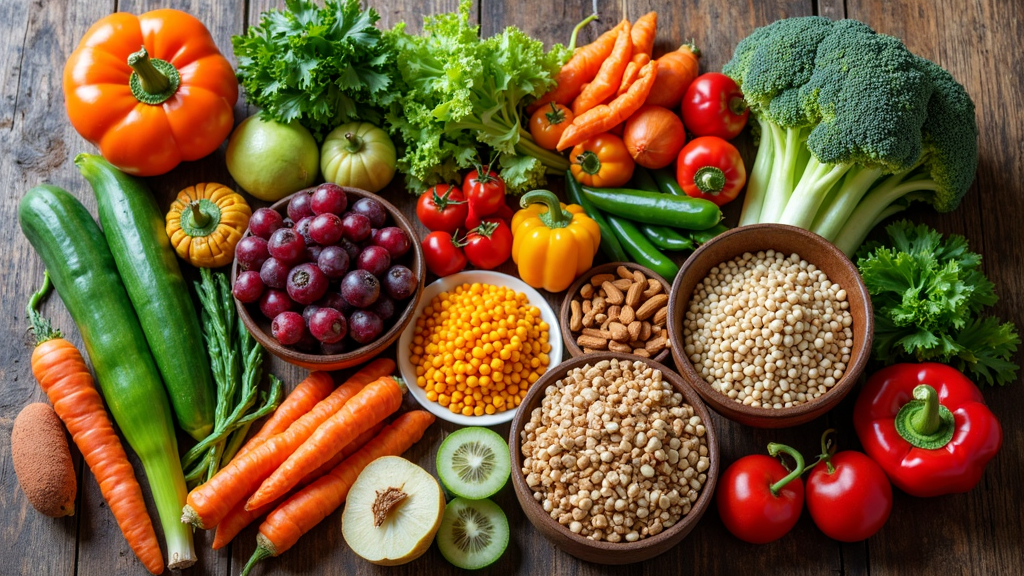Understanding the basics of plantbased nutrition offers a simple way to level up your overall health and wellbeing. Whether you’re going all in on a vegan diet or just swapping a few meals a week, plantbased eating opens up tons of tasty options for everyone. I’m breaking down what you need to know about nutrients, planning meals, and working through the common challenges people run into as they get started with this style of eating.

What Is PlantBased Nutrition?
Plantbased nutrition involves building meals around fruits, vegetables, legumes, grains, nuts, and seeds. Meat, dairy, and eggs don’t play lead roles (and for some, aren’t on the menu at all). For many people, plantbased doesn’t mean you have to ditch animal products entirely, it just means most meals and snacks come from the plant world.
Eating this way has grabbed attention for its potential health perks, its gentler impact on the planet, and the fun of stumbling upon new favorite foods. According to the Harvard T.H. Chan School of Public Health, building a plantforward plate is a great way to load up on vitamins, minerals, and fiber while keeping saturated fat and cholesterol lower.
People sometimes worry about missing nutrients, but with some knowhow, plantbased diets can cover all your bases. There’s also a huge variety in plantbased lifestyles: some people go fully vegan, some stay vegetarian, while others are flexitarians (which is a fancy word for mostly plant, sometimes animal diets).
Key Nutrients in PlantBased Diets
Getting all your nutrients on a plantbased diet just takes a little bit of strategy. Here are a few of the key players everyone should keep on their radar:
- Protein: Beans, lentils, tofu, tempeh, whole grains, and nuts are protein champs. You don’t need to pair proteins perfectly at every meal, just get a variety through the day.
- Iron: Spinach, lentils, and fortified cereals are good sources. Pairing them with foods high in vitamin C (like oranges or peppers) helps your body soak up more iron from plants.
- Calcium: Dark leafy greens (such as bok choy and kale), fortified plant milks, and tofu with calcium sulfate provide a steady supply.
- Vitamin B12: This vitamin is mostly found in animal products, so fortified foods or a supplement is pretty important for people on fully plantbased diets.
- Omega3s: Flaxseeds, chia seeds, walnuts, and certain algaebased supplements deliver these healthy fats.
- Vitamin D: Sunlight is the classic source, but mushrooms and fortified foods can help fill gaps, especially in winter months.
- Zinc & Iodine: Whole grains, beans, nuts, and iodized salt keep you covered.
Paying attention to these nutrients helps prevent little gaps in your diet from turning into bigger issues later on. Checking in with a registered dietitian who’s familiar with plantbased diets is a big help if you ever feel stuck or have questions.
Getting Started with PlantBased Meal Planning
Switching up your meals can be a little intimidating at first, but it doesn’t have to be. I’ve found that just choosing one or two new recipes per week makes the switch up feel more natural. Planning ahead is helpful, especially if you’re worried about protein or other nutrients. Here are some quick meal ideas that work for pretty much anyone:
- Breakfast: Oatmeal topped with berries, nuts, and a splash of plant milk
- Lunch: Loaded grain bowls with brown rice, beans, colorful veggies, and a tahini dressing
- Dinner: Stirfried tofu and broccoli over quinoa, or a hearty lentil soup with crusty bread
- Snacks: Fresh fruit, trail mix, roasted chickpeas, or carrot sticks and hummus
Batch cooking on weekends can make a busy week so much smoother. Cook up a pot of beans, roast a pan of veggies, and portion out some cooked grains for stressfree meals. I’ve also found prepping a big salad and storing the dressing separately makes grabbing lunch a breeze.
What to Watch Out For
Most people run into a few common obstacles as they get started with plantbased eating. Knowing what to look for (and how to dodge simple mistakes) puts you way ahead of the game.
- Not enough calories: Plant foods can be less caloriedense. Adding healthy fats like nut butters, seeds, and avocados helps keep you satisfied.
- Relying on heavily processed options: Sure, burgers that “bleed” are nextlevel cool, but whole or minimally processed foods build a healthier foundation over time.
- Skipping B12: If you’re eating no animal products at all, taking a B12 supplement or eating fortified foods is super important for energy and nerve function.
- Monotonous meals: It’s easy to fall into ruts (hello, endless salads). Mixing up grains, veggies, herbs, and sauces keeps things fun.
- Social hurdles: Special occasions, family gatherings, or eating out can feel tricky at first, but sharing your goals openly and suggesting a few restaurants takes the stress out.
Overcoming Common PlantBased Challenges
Adapting to a new eating style comes with its own learning curve. I’ve found a few tips help people power through the awkward stage and thrive on plants:
- Experiment with new cuisines; Mediterranean, Indian, and Mexican foods all have naturally plantfocused, flavorful dishes.
- Read labels for hidden animal products (look for milk, eggs, gelatin, and honey).
- Don’t sweat perfection; even small changes add up, and you can always reassess what works for you.
- Lean on plantbased communities online or locally for recipe ideas and support.
Helpful Advanced Tips and Tricks
Once you’ve got your basics down, there are a few ways to take plantbased eating from “ok” to “amazing.” Here are some little tips that made a big difference in my kitchen:
Upgrade Your Pantry:
Stock up on versatile staples like beans, canned tomatoes, spices, and whole grains. It makes lastminute meals way less stressful.
Try DIY Plant Milks:
Blending oats, almonds, or cashews with water gives you fresh milk in minutes, with no weird additives or hidden sugar.
Learn the Art of Sauces:
Even simple grains and veggies feel special with a good tahini sauce, homemade salsa, or peanut dressing.
Make Friends With Tofu and Tempeh:
Marinate or grill for extra flavor. Don’t be shy with spices; these proteins can handle it.
Bumping up your kitchen creativity makes every meal more satisfying and helps you stay excited about sticking with plantbased eating for the long run.
Practical Nutrition Tips for Real Life
Switching to plantbased is easier when you don’t feel boxed in, so I like to keep meals flexible. If you’re on the go, lots of grocery stores sell healthy snacks like roasted nuts, dried fruit, or readytogo salads.
- Travel: Pack your own snacks when heading out. Airport or gas station food can be a gamble.
- Eating out: Look for cuisines that offer veggie mains, like Thai curries, Ethiopian lentil stews, or Middle Eastern platters. Don’t be shy about asking for substitutions.
- Kids and family: Getting everyone on board can be smoother if you keep meals familiar (spaghetti, chili, tacos) but swap in beans or lentils instead of ground meat.
Frequently Asked Questions
Here are some of the most common questions I hear from people interested in checking out plantbased nutrition:
Question: How do I make sure I’m getting enough protein?
Answer: Focus on eating a variety of proteinrich foods like beans, lentils, tofu, tempeh, whole grains, nuts, and seeds. Tallying up your protein for a few days can help ease any worries, and you’ll probably hit your needs without issue.
Question: Is eating plantbased expensive?
Answer: It doesn’t have to be. Staples like beans, rice, oats, and frozen veggies are pretty budgetfriendly. Processed vegan “mock meats” and specialty snacks can add up, but basic whole foods keep your grocery bills in check.
Question: Will I have enough energy for workouts?
Answer: Absolutely. As long as you eat enough total calories and remember to include some healthy fats, complex carbs, and proteins in your meals, you should have plenty of energy. Many top athletes thrive eating plantbased, like Serena Williams or Lewis Hamilton.
How PlantBased Nutrition Fits RealWorld Lifestyles
Plantbased eating fits almost any lifestyle, whether you’re feeding a big family or cooking for one. At gatherings and potlucks, I like to bring a crowdpleasing dish—think colorful grain salads or veggiepacked stews. Often, they’re some of the first foods to disappear!
- For busy schedules: Slow cookers, sheetpan dinners, and batchprepped salads are real lifesavers.
- On a budget: Shopping bulk bins, using frozen produce, and planning simple meals can stretch your dollar.
- For food lovers: Challenge yourself to cook a new vegetable once a week or try new international recipes.
Whether you’re motivated by health, sustainability, or just curiosity, adopting some plantbased nutrition habits brings new flavors, textures, and health perks into your daily life.
Keeping things flexible, balanced, and fun makes it way more likely that you’ll stick with plantbased eating for the long haul. When I first made the switch up, just being open to trying new foods made all the difference. Enjoy the process of tracking down new dishes, and find what works for you as your tastes and needs glowup over time.
If you’re curious about exploring even more, public libraries and online resources are packed with cookbooks, documentaries, and stories of people who have made the switch. Cooking at home, sharing meals with friends, or checking out local plantfriendly restaurants can all mix in some variety and spark inspiration for your next meal. No matter where you start, every little step adds up to better health, bigger flavor, and a more vibrant life—one tasty plate at a time.
